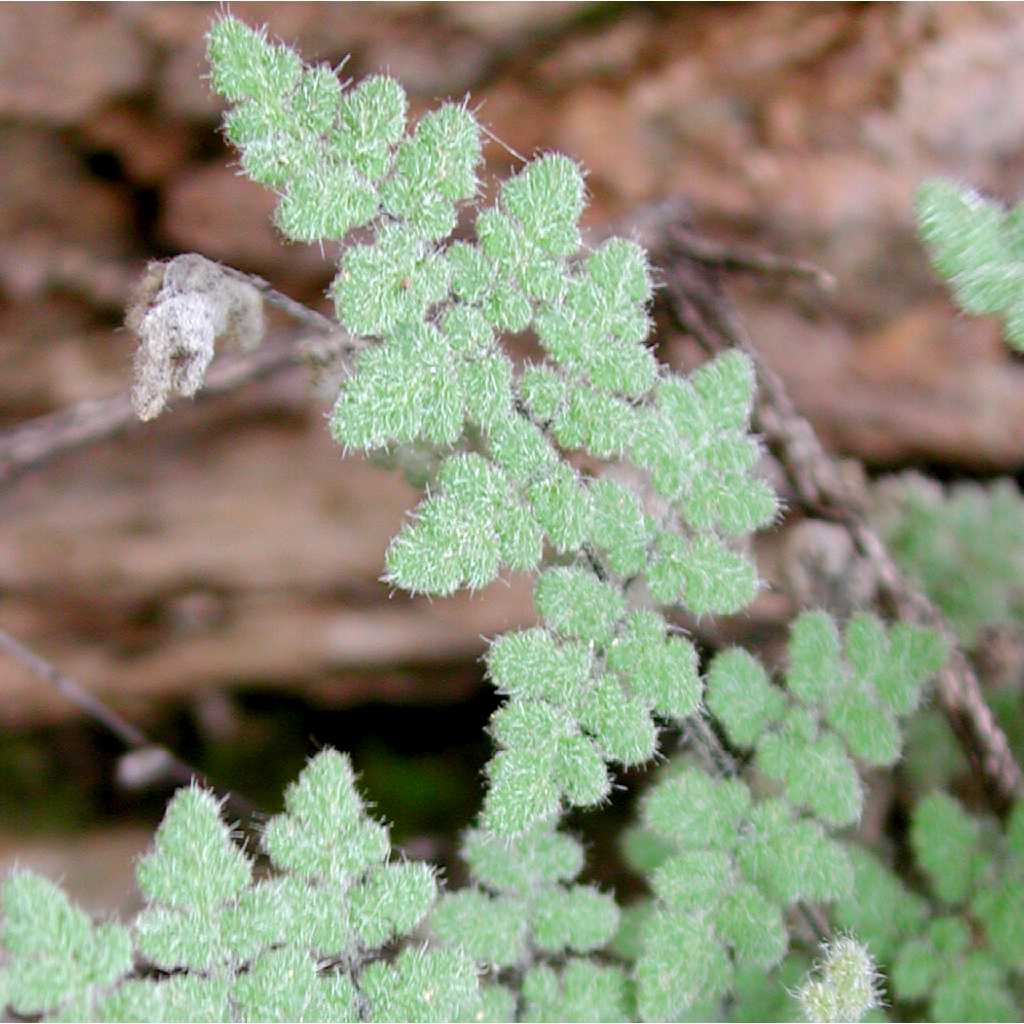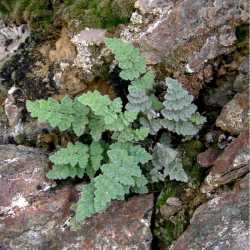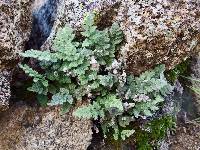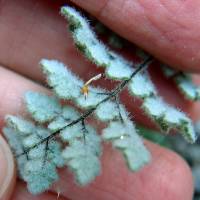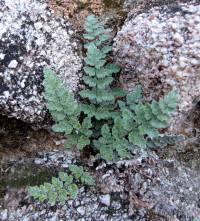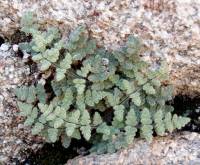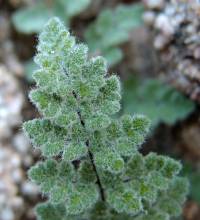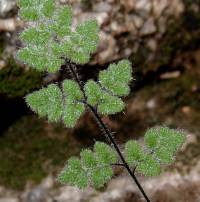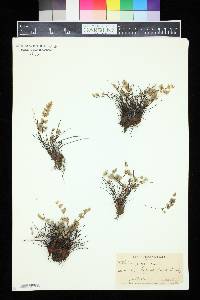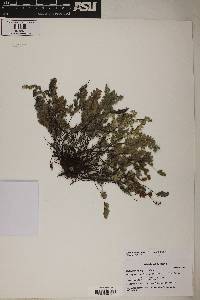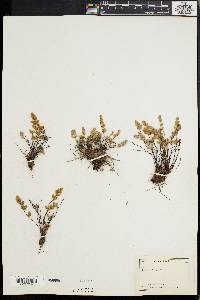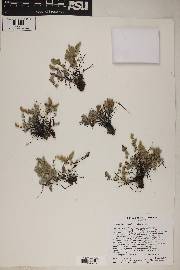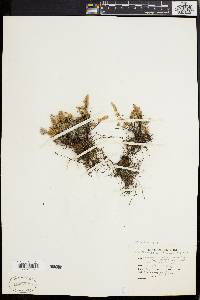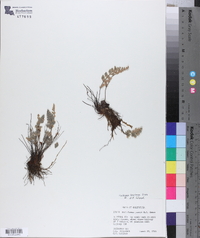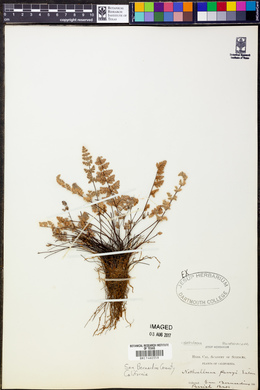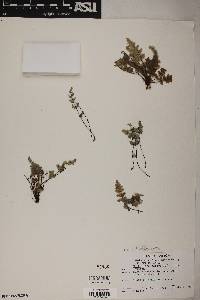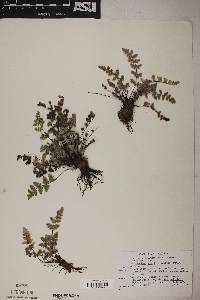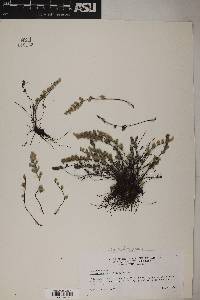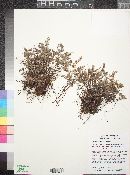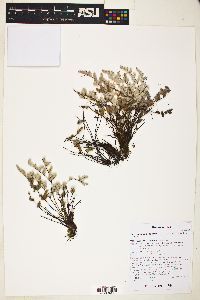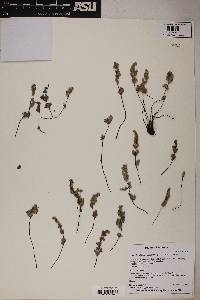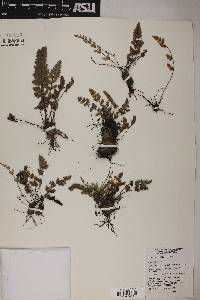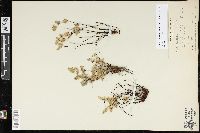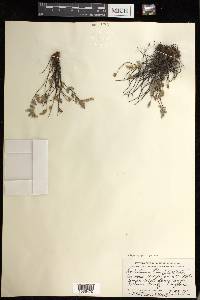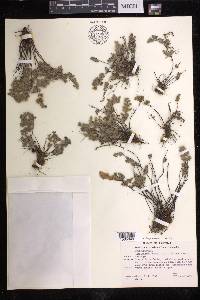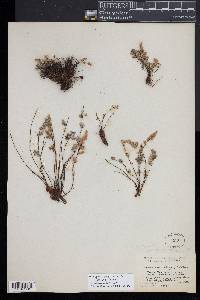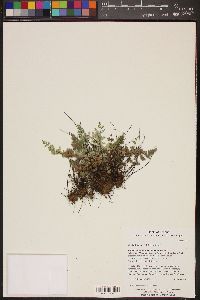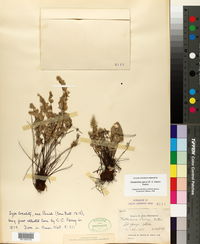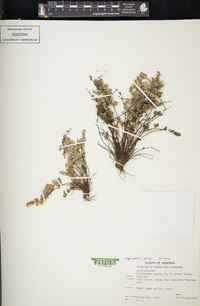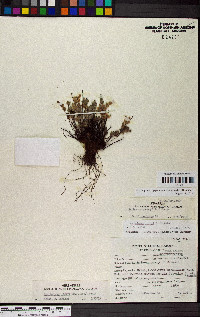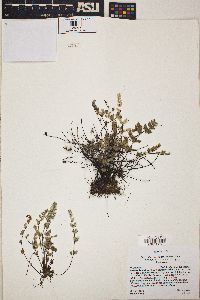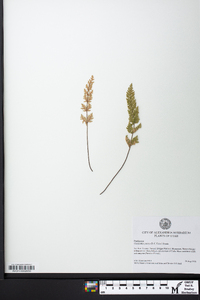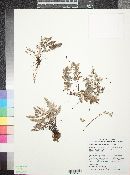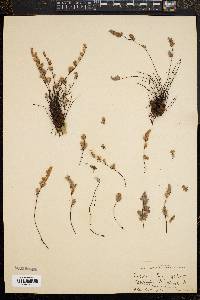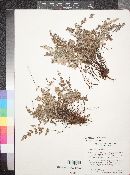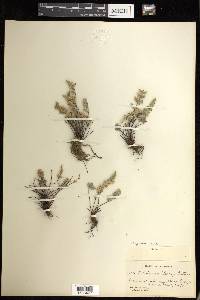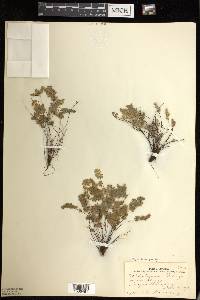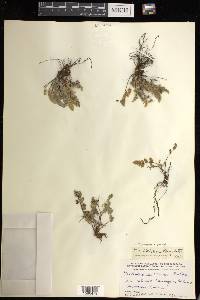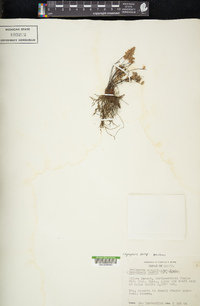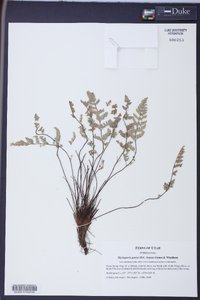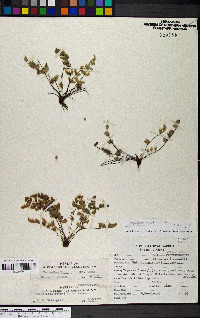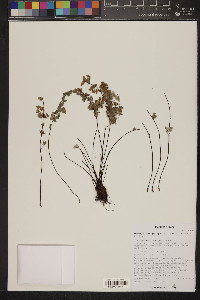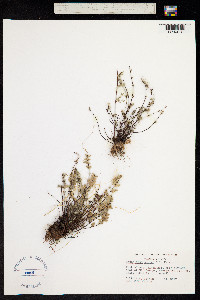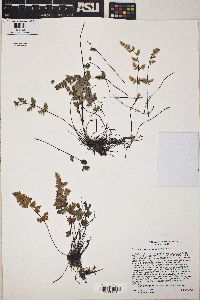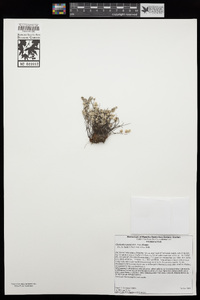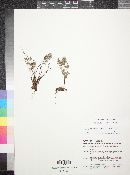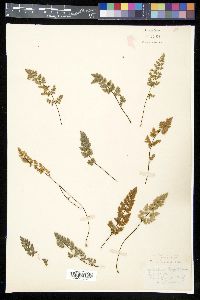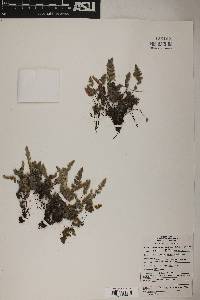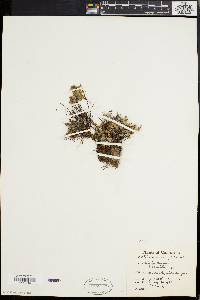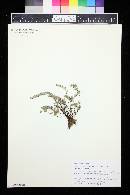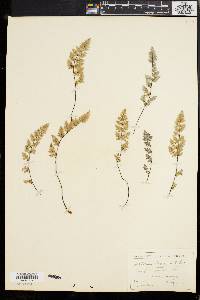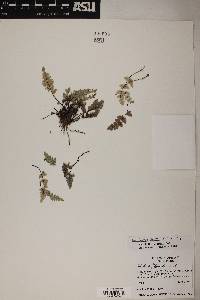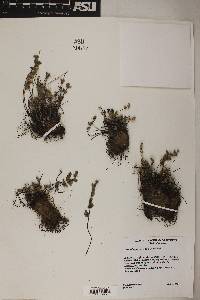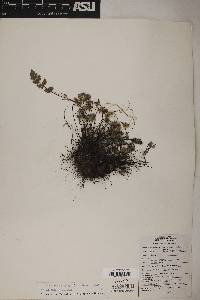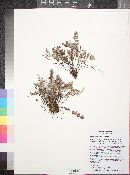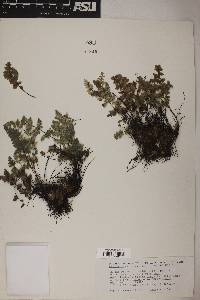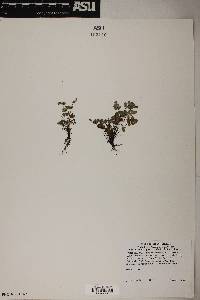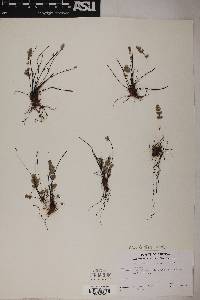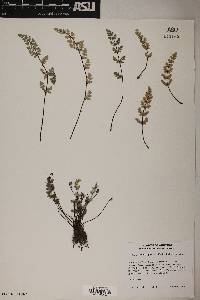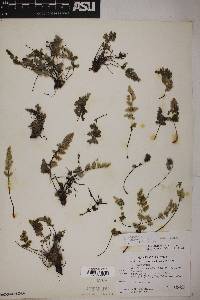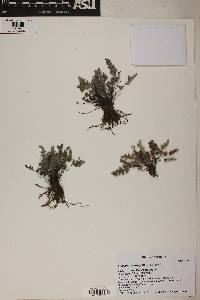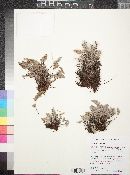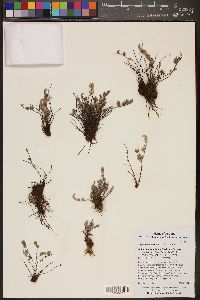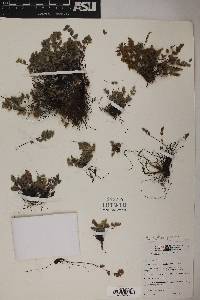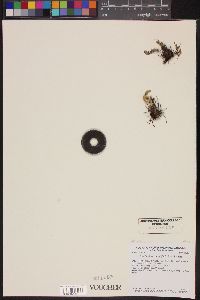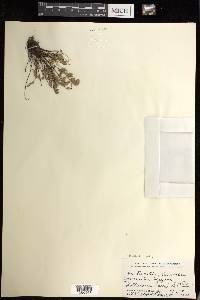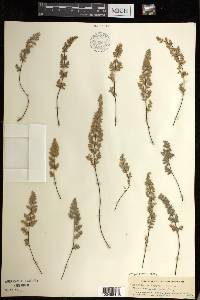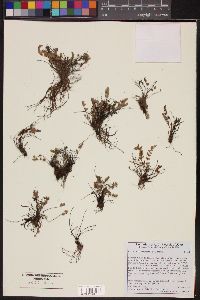
|
|
|
|
Family: Pteridaceae
Parry's Lip Fern, more...Parry's lipfern, Parry lipfern (es: helecho)
[Cheilanthes parryi (D. C. Eaton) Domin, moreNotholaena parryi D. C. Eaton] |
Stems compact to short-creeping, 3--10 mm diam.; scales often uniformly brown but at least some on each plant with well-defined, dark, central stripe, linear-lanceolate, straight to slightly contorted, loosely appressed, persistent. Leaves clustered, 4--20 cm; vernation circinate. Petiole dark brown to black, rounded adaxially. Blade lanceolate to linear-oblong, usually 2-pinnate-pinnatifid at base, 1--4 cm wide; rachis rounded adaxially, lacking scales, with dense monomorphic pubescence. Pinnae not articulate, dark color of stalk continuing into pinna base, basal pair usually smaller than adjacent pair, ± equilateral, appearing densely villous adaxially. Costae brown adaxially for most of length; abaxial scales absent. Ultimate segments oblong to lanceolate, not beadlike, the largest 3--5 mm, abaxially and adaxially densely villous with long, segmented hairs. False indusia absent. Sori ± continuous around segment margins. Sporangia containing 64 spores. 2 n = 60. Sporulating late spring--fall. Cliffs and ledges, on a variety of substrates including limestone and granite; 100--2300 m; Ariz., Calif., Nev., Utah; Mexico in Baja California, Sonora. Many authors assign Cheilanthes parryi to Notholaena , but it is distantly related (at best) to the type species of that genus, and we concur with R. M. Tryon and A. F. Tryon (1982) that it should be tranferred to Cheilanthes . Further support for this generic placement is provided by the fact that C . parryi hybridizes with C . covillei to form the sterile diploid C . × parishii . Cheilanthes parryi is most often confused with C . feei , from which it can be distinquished by its coarser, denser pubescence and larger ultimate segments.
General: Compact to short-creeping stems, 3-10 mm in diameter, scales often uniformly brown with at least some well-defined, dark, a central stripe, linear-lanceolate, straight to slightly contorted, loosely appressed, and persistent. Leaves: Clustered, 4-20 cm, circinate vernation, dark brown to black petiole, rounded above; blade lanceolate to linear oblong, usually 2-pinnate-pinnatifid at base, 1-4 cm wide, rachis rounded above, lacing scalses with dense monomorphic pubescence; pinnate not articulate, dark color of stalk continuing into pinna base, basal pair usually smaller than adjacent pair, equilateral, appearing densely villous above; midvein brown above for most of length; scales absent beneath; ultimate segments oblong to lanceolate, not beadlike, 3-5 mm, densely villous above and below. Sporangia: Contains 64 spores, no false indusia, sori more or less continuous around the segment margins. Ecology: Found on cliffs, ledges, in crevices of canyon walls, often in very hot, dry situations from 1000-6500 ft (305-1981 m); sporulating late spring-fall. Notes: Superficially resembles C. feei but is easily distinguished by the coarser, denser hairy upper surfaces of the segments; C. parryi is mostly bipinnate or bipinnate-pinnatifid and the segments are much longer than wide, often 2.5-3.5 mm long. Etymology: Cheilanthes is from Greek cheilos for lip and anthos for flower, while parryi is named for Dr. Charles Christopher Parry (1823-1890), an English born American botanist. Sources: FNA 1993, Kearney and Peebles 1969 FNA 1993, Kearney and Peebles 1969 Common Name: Parry's lipfern Rarity: None General: Compact to short-creeping stems, 3-10 mm in diameter, scales often uniformly brown with at least some well-defined, dark, a central stripe, linear-lanceolate, straight to slightly contorted, loosely appressed, and persistent. Leaves: Clustered, 4-20 cm, circinate vernation, dark brown to black petiole, rounded above; blade lanceolate to linear oblong, usually 2-pinnate-pinnatifid at base, 1-4 cm wide, rachis rounded above, lacing scalses with dense monomorphic pubescence; pinnate not articulate, dark color of stalk continuing into pinna base, basal pair usually smaller than adjacent pair, equilateral, appearing densely villous above; midvein brown above for most of length; scales absent beneath; ultimate segments oblong to lanceolate, not beadlike, 3-5 mm, densely villous above and below. Sporangia: Contains 64 spores, no false indusia, sori more or less continuous around the segment margins. Ecology: Found on cliffs, ledges, in crevices of canyon walls, often in very hot, dry situations from 1000-6500 ft (305-1981 m); sporulating late spring-fall. Notes: Superficially resembles C. feei but is easily distinguished by the coarser, denser hairy upper surfaces of the segments; C. parryi is mostly bipinnate or bipinnate-pinnatifid and the segments are much longer than wide, often 2.5-3.5 mm long. Ethnobotany: Unknown, but other species in the genus have uses. Etymology: Cheilanthes is from Greek cheilos for lip and anthos for flower, while parryi is named for Dr. Charles Christopher Parry (1823-1890), an English born American botanist. Synonyms: Notholaena parryi, Myriopteris parryi Editor: SBuckley, 2010 |
|
|
|
This project was made possible in part by the Institute of Museum and Library Services [MG-70-19-0057-19].
Powered by Symbiota

